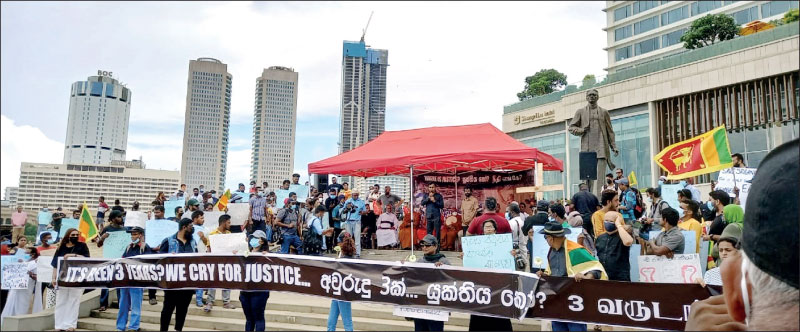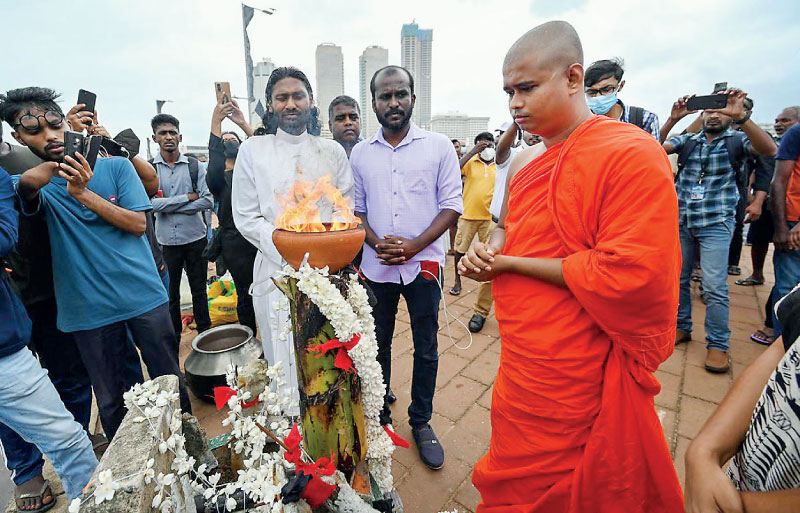Monday Apr 28, 2025
Monday Apr 28, 2025
Friday, 20 May 2022 00:20 - - {{hitsCtrl.values.hits}}


SOME DAY, when our crying’s done... Until then, Sri Lanka shows the world how to wear a smile and walk in the sun – despite the deluge of disasters pouring down like rain... Instead of the justice we so vociferously demand and so richly deserve
 While the country at large waited for Rajapaksa Bros. & Co. to go home today or tomorrow, its citizens commemorated two important events of yesteryear.
While the country at large waited for Rajapaksa Bros. & Co. to go home today or tomorrow, its citizens commemorated two important events of yesteryear.
The first of these was the Easter Sunday suicide bombings of 2019. The other was the end to the militarised phase of our island nation’s protracted ‘civil war’.
Though Black Easter – as much as Black July and its aftermath – will never be forgotten, it is important to remember both right.
A large part of the healing process for a land that has been torn apart by its leaders, rulers and governors of all kinds is that the people do – and are permitted to – properly commemorate their sense of loss and express any ongoing grievances.
And now that the citizenry are able to do so openly – together, plus spared of any fear of immediate or implied reprisals – it is all the more vital to engage in such reminiscing in the correct spirit.
A trinity of years to carry this cross
It has been three years and a month to date since a series of explosions ripped through hotels and churches in the commercial capital, and one in the eastern province.
Since that fateful and fearsome day, it has felt as if the long-drawn-out war against our island-nation’s innocents has never really ended.
Even now, a military presence heavier than any seen during the nearly three-decades-long war marks Colombo’s rain-sodden streets... these curfews and clampdowns are an emergent phenomenon on a road to rapid and all-encompassing militarisation, which must be averted. Encouraging citizen protests in the face of the Emergency is a no-brainer.
The cost to life and limb from that darkened Easter’s carnage was gruesome, and the scars still show.
And the cross that too many guiltless citizens have had to carry on their long ‘via Dolorosa’ is evident in the number of physically maimed and emotionally wounded who mark the grim anniversary by water-logged graves each year since 2019.
A plethora of the usual suspects – some sinister, others perhaps scapegoats or hired subversives – have been arrested, indicted and incarcerated.
A few perpetrators on the frontlines of a hidden war being waged by vested interests have taken their own lives – to face whatever judgment, fate, karma or kismet awaits them on the other side of death in our paradise isle...
Yet, there is a nagging sense that closure for the victims and their families – and judgement for those guilty of this heinous crime – has been left undone.
This unease has been compounded by a lack of definitive findings by police, state and military intelligence investigations; parliamentary select committees to probe the incident; and a presidential commission of inquiry whose full findings have been edited prior to release – ostensibly for state security.
Irony, much, sir?
It is an unease that has a sharp spear thrust painfully into the body politic’s side each time a prince of the church expresses doubts as to who the real mastermind behind the dastardly attack was.
Or another man of the cloth is summoned for the umpteenth time to make a statement to the Criminal Investigation Department – when all he and his brother clergy have been doing since ‘4/21’ is making statements (whether at the CID, in the cloister of press conferences or on the city streets).
And criminal activities by those far higher up than humble men of the cloth goes uninvestigated by any department!
This year though, unlike years past, where to say ‘there is closure’ was to be guilty of a conspiracy theory, the unease and inability to lay to rest the horrible spectre of three years past was out in the open.
At several significant venues – from iconic GotaGoGama where Occupy Galle Face dedicated a day to remembrances of Easter Sunday 2019, to still-bleeding Katuwapitiya from where a majority of the 269 who died hailed – ‘4/21’ was marked with poise, pathos, passion.
A man carried a cross from Negombo to Colombo to protest the egregious slaughter and express his outrage at the long delay in justice.
Men, women, and children who are crucified daily when they recall the horror of that black day in nightmares and waking terrors got to remember – and recriminate at the securocracy that was elected to safeguard us. And ensure punishment for the crimes of those who let the massacre happen at all. Much more mastermind it.
Justice delayed is justice denied. And its victims and petitioners span the gamut.
It may never come for islanders from all walks of life who have seen successive governments pass the buck, spare their cohorts on both sides of the political fence the blame and blithely move on.
Not in this life at least.
But despite the seeming hopelessness of the situation, the people stood united in their sorrowful recollections of the tragedy. And one day, the fact that citizens of all dispensations and political as well as religious beliefs or lack thereof, held hands and wept together in solidarity for slaughtered innocents will be a nostalgic memory in itself.
Winning the war while losing the plot
It has been thirteen years and a few days since former President Mahinda Rajapaksa kissed Sri Lankan soil in an erstwhile version of ‘One Country, One Law.’
That emblematic embrace signified an end to a 26-year-old civil war that was hardly civil and that has not wholly ended.
Yet, it was a landmark event in that it established national sovereignty and territorial integrity after a military conflict that supposedly more civilised western and world powers were pleased to call “Sri Lanka’s ‘unwinnable’ war”.
Today, at least one of the architects – or even two – of the politico-military troika that was credited with the ‘war-victory’ has gone from hero to zero...
They’re living embodiments of the truism that one may – nay, must – retire with grace at the height of one’s glory lest one lives long enough to become entombed in villainy.
Be that as it may, the focus in commemorations of this keystone day in the arch of our island’s chequered history shifted. From the politicians who won their battles to the people who almost inevitably lost the war. And with it – everything worth possessing amidst the changes and chances of this fleeting existence.
This, after over a decade of jingoistic administrations stoking again and again the fires of a nationalism that knew no difference between dissent and patriotism, is very welcome and must be nurtured as a scared flame.
Happy then are those few – representing the many who couldn’t make it, mostly due to curfew curtailed districts between them and Galle Face, and queues for fuel miles long – who dropped their party’s previously jealously protective colours and clutched the bloodstained national flag.
Not to praise Caesar. But to bury him! And resurrect true national feeling again...
It is a new ‘nationalism’ that knows no caste or creed other than ‘citizen supremacy’. This ‘sovereignty of the people’ must sooner than later come to include not merely the dissenters in the west and south but also the north and east. Not to disrespect anyone but include all and especially the living-dead.
The importance of this being both constitutionally mandated and legally enforced cannot be underestimated or over-emphasised – especially under a regime where one law prevails for the ‘political south’ and another for the ‘rest’.
Witness the egregious injunction against an outspoken Tamil MP in his seat, who was only recently prevented by the police from voicing his protest in the east while his compatriots in the west gave due song to their displeasure of the President – a motion that Parliament would rather not debate, to its disgrace and the chagrin of frustrated opposition MPs.
Never before has the idea that the people are sovereign over ethnic-supremacy-waving patriotism been so palpable as it was at GotaGoGamas all over the island; and until recently, MynaGoGama also.
That the mynah in question still flies by courtesy of the state and at the citizen taxpayer’s cost – while angry parents queue with tired, hungry children for half a tank of life-saving ‘liquid gold’ – is to his shame, our regret and the dwindling credit grudgingly afforded to the former Prime Minister’s successor.
Justice will be when both the discredited ‘national saviour’ and his ‘defenders of the faith’ who tout saving a dying nation in the guise of saving a lingering dynasty are not only exposed as they are but also brought to book.
There are many times, names and places written on the bleeding hearts of islanders across the spectrum and down the ages... 1948, 1956, 1983, Colombo, Jaffna Public Library, 1987-9, Central Bank 1996, Kilinochchi, Nandikadal, Mullivaikkal – to name but a few; and now, also add Rathuspaswela and Rambukkana to that blood-soaked list...
But until and unless each and every Sri Lankan who carries a wound, scar, flame or tear-stained cheek from these emblematic events can grieve equally – fairly, freely, in confraternity – the blood of lost generations would have been shed in vain.
And the sweat, toil and tears of the hard years ahead of us now would be a bitter cup to drain if the sacrifices made and lives offered up on the altar of pragmatism, greed for power and corruption have been in vain.
Each dead person slain and mourned is a martyr in the cause of a new nationalism – one not mandated by law or falsely protected by the constitution.
But safeguarded by an inviolable trust – by the people, in the people, of the people.
In which only a neighbour – and never again, an elected representative – can betray a trust placed in them.
| Editor-at-large of LMD | Scion of a sunny-rainy island |
Discover Kapruka, the leading online shopping platform in Sri Lanka, where you can conveniently send Gifts and Flowers to your loved ones for any event including Valentine ’s Day. Explore a wide range of popular Shopping Categories on Kapruka, including Toys, Groceries, Electronics, Birthday Cakes, Fruits, Chocolates, Flower Bouquets, Clothing, Watches, Lingerie, Gift Sets and Jewellery. Also if you’re interested in selling with Kapruka, Partner Central by Kapruka is the best solution to start with. Moreover, through Kapruka Global Shop, you can also enjoy the convenience of purchasing products from renowned platforms like Amazon and eBay and have them delivered to Sri Lanka.
Discover Kapruka, the leading online shopping platform in Sri Lanka, where you can conveniently send Gifts and Flowers to your loved ones for any event including Valentine ’s Day. Explore a wide range of popular Shopping Categories on Kapruka, including Toys, Groceries, Electronics, Birthday Cakes, Fruits, Chocolates, Flower Bouquets, Clothing, Watches, Lingerie, Gift Sets and Jewellery. Also if you’re interested in selling with Kapruka, Partner Central by Kapruka is the best solution to start with. Moreover, through Kapruka Global Shop, you can also enjoy the convenience of purchasing products from renowned platforms like Amazon and eBay and have them delivered to Sri Lanka.